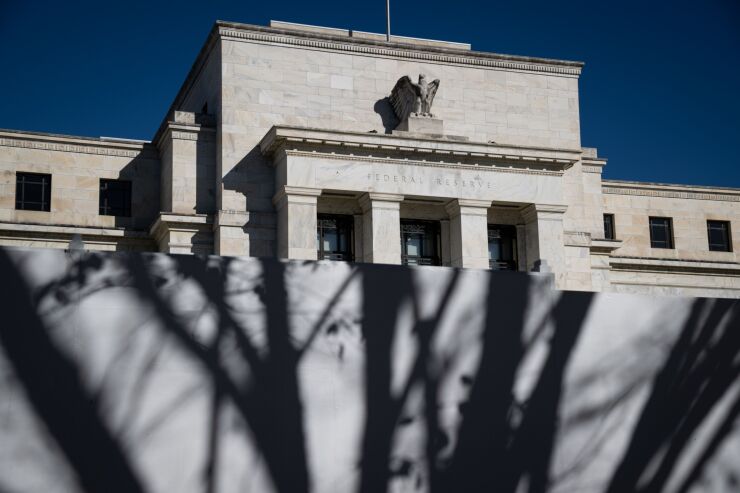
Beyond the much-anticipated relief for regional and community banks'
The central bank ratcheted up rates in 2022 and last year to combat inflation that soared in the Covid-19 pandemic's wake. Fed Chair Jerome Powell said last week that the rate of price increases had eased enough — from above 9% to below 3% — for policymakers to shift attention away from inflation and toward the job market, the second prong of the Fed's dual mandate.
"Inflation has declined significantly. The
He vowed that "we will do everything we can" to support a labor market that is still advancing but at a slower pace. The futures market is pricing in a 25-basis-point cut in September with a chance for a 50-basis-point move. Analysts widely expect further rate reductions later this year and into 2025.
Should the Fed march down that path, it would lower borrowing costs and could stimulate stronger loan demand that could boost banks' interest income. Reduced credit costs could also ease concerns about vulnerable commercial real estate borrowers defaulting on loans.
CRE customers will "find it easier, and cheaper, to refinance these loans," said Allen Puwalski, chief investment officer at Cybiont Capital.
Puwalski, an independent director at the $119 billion-asset New York Community Bancorp and its Flagstar Bank unit, also noted that "over half of all banks are suffering negative carry," a profit-sapping headwind that develops when the cost of holding an investment exceeds the income it generates.
"Banks with excess cash on their balance sheets loaded up" on mortgage-backed securities "only to see those holdings lose value" when rates spiked and competition for deposits ramped up over the past two years, Puwalski said.
When interest rates rise, mortgage-backed securities prices fall because investors can earn higher yields from new securities, depreciating the value of existing holdings.
"At the same time, deposit outflow meant those same banks often had to borrow to maintain required capital levels," Puwalski said. "The cost of that borrowing in many cases exceeded the income from the mortgage-backed securities, creating the negative carry…If rates start to come down this process will begin to unwind, which should be good for these banks."
Lower rates would also trim deposit costs to deliver another plus for banks. But this will take time and likely develop over several quarters. Adjustable rate loans, meanwhile, will reset immediately. This could hurt lenders' margins late this year and early next, as the interest banks earn on certain loans would decline faster than the rates paid for deposits, said Neil Stevens, president and CEO of the $600 million-asset Oconee Financial in Watkinsville, Georgia.
Deposit competition remains elevated, Stevens said. As such, banks cannot simply cut the rates they pay depositors. They will instead have to slowly reap the benefits of lower rates on the future deposits they gather.
"So in the near term, we would expect some margin pressure," Stevens said. "Lower rates will certainly ease credit pressure, but I think it's important to remember that when the Fed cuts, there will be some good, some bad. That said, we always face a headwind of some sort. It's a matter of identifying the challenges and managing through them."
He said the job market and the economy, while showing signs of slowing down, remain firmly in positive territory. The Fed, he said, does not have to slash rates; it can move methodically over the remainder of this year and next to gradually bring its benchmark rate lower. If it does this, he said, banks can make small adjustments and adapt along the way.
The Commerce Department reported U.S. gross domestic production, the broadest measure of the economy, grew 2.8% in the second quarter, down from the 2023 peak near 5%. The Labor Department reported that U.S. employers added 114,000 jobs in July — still solid but notably down from the prior month. Additionally, payroll gains were revised down in June by 27,000 to 179,000.
The unemployment rate rose to 4.3% in July from 4.1% the previous month, reaching the highest level since October 2021, yet remaining low by historical standards.
"Economic fundamentals do not indicate a need for a 50-basis-point cut" in September "and the Fed should preserve firepower" in case of an unforeseen shock that would necessitate greater action, said Adrian Vlad, a portfolio manager at Sidekick Money Ltd.
Raymond James Chief Investment Officer Larry Adam agreed.
"While the market has priced in an aggressive, front-loaded easing cycle — nearly 200 basis points of rate cuts are expected over the next 12 months — the pace and magnitude of the Fed's rate path will be dictated by the incoming economic data," Adam said. "The good news: the Fed has plenty of room to ease if needed."





